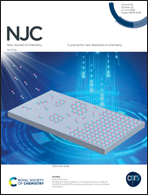Imidazolium-based ionic liquids with increasing alkyl chain length of cations decrease the stability and fibrillation propensity of lysozyme†
Abstract
Ionic liquids (ILs) are neoteric solvents with a wide range of applications. Interaction of ILs with proteins alters their stability and self-aggregation. The present work analyses the effect of hydrophobic interactions between protein and ILs using lysozyme (Lyz) and methylimidazolium-ILs with the side-chain substitutions of H (MIC), ethyl (EMIC), butyl (BMIC), hexyl (HMIC), and octyl (OMIC) groups. Below 100 mM, ILs decrease the rate of fibrillation, with MIC showing the largest reduction. Above 100 mM, the rate is sharply increased; however, a further increase in the concentration reduces the rate. Also, the fibrillation mechanism is shifted from nucleation-independent polymerization to a nucleation-dependent mechanism with a measurable lag phase, except in MIC. Above 200 mM, HMIC increases the apparent fibrillation time nearly 55-fold and OMIC inhibits the fibrillation. Spectroscopic and docking studies suggest that the binding affinities are such that OMIC > HMIC > BMIC ≈ EMIC ≈ MIC. Thermal denaturation experiments predict that at lower concentrations (≤20 mM) the destabilization by MIC is greater, whereas at higher concentrations the destabilizing effect increases for ILs with longer alkyl chains. Overall, the results suggest that increasing the hydrophobicity of the IL increases its binding affinity with Lyz, which decreases the thermal stability and fibrillation propensity of the protein.



 Please wait while we load your content...
Please wait while we load your content...